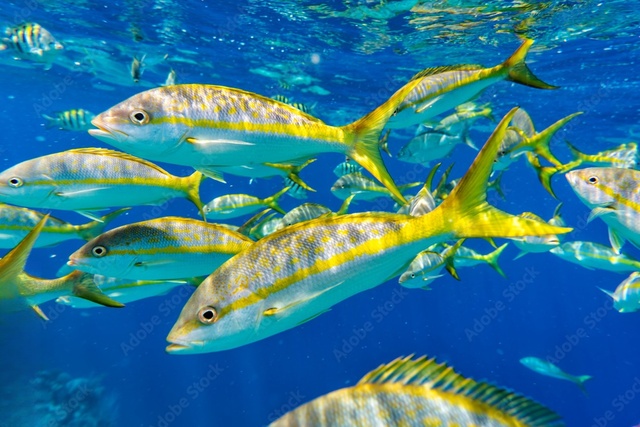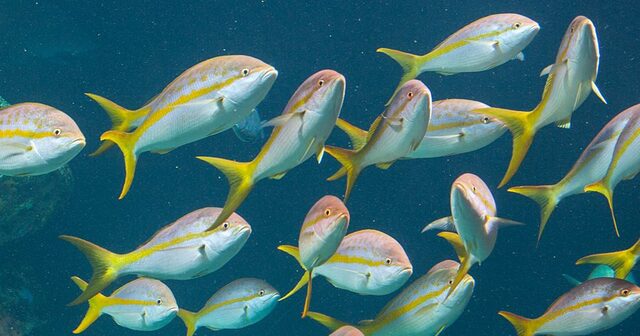The Yellowtail Snapper (Ocyurus chrysurus) is a vibrant, widely recognized fish species found in the tropical waters of the Western Atlantic. Known for its striking yellow tail and excellent flavor, the Yellowtail Snapper holds significant ecological, cultural, and economic importance. This article provides an in-depth exploration of Ocyurus chrysurus, focusing on its scientific classification, physical characteristics, habitat, behavior, migration patterns, and conservation status.

The Yellowtail Snapper is scientifically classified under the following taxonomic categories:
Kingdom: Animalia
Phylum: Chordata
Class: Actinopterygii
Order: Perciformes
Family: Lutjanidae
Genus: Ocyurus
Species: Ocyurus chrysurus
The Lutjanidae family, commonly known as the snapper family, includes many commercially important fish species, and the Yellowtail Snapper is one of the most notable due to its distinct appearance and widespread popularity.
The Yellowtail Snapper was first described by the famous marine biologist Edward Drinker Cope in 1860. Early research focused on the species’ ecological role in the Western Atlantic, as well as its value as a food fish. Over time, further studies have contributed to understanding its life cycle, migration patterns, and response to environmental changes, particularly in areas influenced by human activities like overfishing and habitat degradation.
The Yellowtail Snapper is known for its vibrant coloration and unique physical traits that make it easily recognizable:
Appearance: The body is streamlined and elongate with a brilliant yellow tail and a horizontal yellow stripe running from the snout to the tail. The back is blue-gray to greenish, while the belly is silver-white.
Size: Yellowtail Snapper typically grows to around 40-50 cm (16-20 inches) in length, though larger individuals can reach up to 75 cm (30 inches).
Weight: They can weigh up to 3.5 kg (7.7 lbs), though the average size is usually smaller.
Lifespan: In the wild, Yellowtail Snapper can live for about 10-15 years, depending on environmental factors and fishing pressures.
Their vibrant tail and sleek body make them a popular target in both commercial and recreational fishing.
Ocyurus chrysurus is primarily found in the Western Atlantic, specifically:
Range: From the Florida Keys and the Gulf of Mexico to the Caribbean Sea and Bermuda, as well as along the Brazilian coast.
Habitat: Yellowtail Snapper are typically found in shallow waters, particularly around coral reefs, rocky outcrops, and seagrass beds. They prefer water temperatures ranging from 22°C to 30°C (72°F to 86°F), which is typical of tropical and subtropical regions.
Depth: They are commonly found at depths between 10 to 60 meters (33 to 197 feet), although they can occasionally venture deeper depending on food availability.
These habitats provide the necessary shelter and food sources that Yellowtail Snapper need for survival, including crustaceans, small fish, and various invertebrates.
The Yellowtail Snapper plays an important role in the marine food web. Its ecological behavior includes:
Feeding: The Yellowtail Snapper is an omnivorous carnivore, feeding on small fish, crustaceans, and other invertebrates. It is an opportunistic feeder, often hunting in schools and actively foraging on reefs.
Social Behavior: These fish are highly social and often form schools, which can number from a few individuals to several hundred, depending on the size of the habitat.
Territoriality: Although they are social, they can also be territorial, especially during the breeding season when they defend their space for nesting.
Their schooling behavior provides protection from predators and allows for coordinated hunting strategies.
Unlike some species that engage in long migrations, the Yellowtail Snapper exhibits more localized movement patterns, typically shifting to different feeding or spawning grounds within their home range.
Spawning Season: Yellowtail Snapper spawn during specific times of the year, typically during the full moon in the spring and summer months, when they congregate in large numbers to reproduce.
Seasonal Movements: They may also migrate to different parts of the reef to find optimal feeding grounds, especially during seasonal changes in water temperature.
These migration patterns are primarily driven by food availability, water temperature, and the need for suitable spawning habitats.

The Yellowtail Snapper exhibits both solitary and social behaviors throughout its life cycle:
Feeding Patterns: During the day, they often rest in crevices or under ledges to avoid predators and then become active feeders at dawn and dusk.
Schooling Behavior: As juveniles, they tend to stay in smaller schools for protection, while adults may join larger schools for migration and feeding.
Reproductive Behavior: During the breeding season, males compete for females, often engaging in visual displays and establishing dominance within their territory.
As carnivorous feeders, the Yellowtail Snapper’s diet consists primarily of:
Small Fish: They hunt and feed on small species of fish found around coral reefs and rocky structures.
Crustaceans: Shrimp, crabs, and other crustaceans form an important part of their diet.
Invertebrates: Various invertebrates, including mollusks and squid, are also consumed.
The Yellowtail Snapper is an opportunistic feeder, using its agility and schooling behavior to catch prey efficiently.
Spawning: Yellowtail Snapper spawn in large groups during the spring and summer months, typically around the full moon when water conditions are optimal.
Fecundity: Females can release thousands of eggs at once, which are fertilized externally by males.
Parental Care: After fertilization, the eggs are left to develop on the reef, with no direct parental care given to the offspring.
The reproductive success of the Yellowtail Snapper is closely tied to the health of the reef ecosystems where they spawn.
Currently, Ocyurus chrysurus is classified as a species of Least Concern by the International Union for Conservation of Nature (IUCN). However, this species faces certain threats:
Fishing Pressure: Overfishing, especially in commercial fisheries, can reduce population numbers.
Habitat Loss: Coral reef degradation and pollution pose significant threats to Yellowtail Snapper habitats.
Climate Change: Changes in ocean temperatures and acidification are impacting reef ecosystems, potentially affecting Yellowtail Snapper populations.
To help safeguard the Yellowtail Snapper, several conservation strategies are being implemented:
Marine Protected Areas (MPAs): Designating areas where fishing is restricted helps ensure healthy populations of Yellowtail Snapper.
Fishing Regulations: Enforcing size and bag limits, as well as seasonal closures, ensures sustainable fishing practices.
Coral Reef Restoration: Efforts to restore damaged coral reefs are crucial in maintaining the habitats where Yellowtail Snapper thrive.
The Yellowtail Snapper provides considerable ecological and economic value:
Ecological Role: As a predator, it helps maintain balance in the reef ecosystem by controlling populations of smaller fish and invertebrates.
Economic Value: Yellowtail Snapper is highly valued in the commercial and recreational fishing industries, contributing to local economies in the Caribbean, Florida, and other tropical regions. Its firm, white flesh makes it a popular choice in seafood markets and restaurants.
Below is a table highlighting the closest relatives of Ocyurus chrysurus within the Lutjanidae family:
| Species | Common Name | Distribution | Size (Length) | Conservation Status |
|---|---|---|---|---|
| Lutjanus campechanus | Red Snapper | Western Atlantic | 90 cm | Vulnerable |
| Lutjanus griseus | Gray Snapper | Western Atlantic | 60 cm | Least Concern |
| Lutjanus vivanus | Lane Snapper | Western Atlantic | 50 cm | Least Concern |
The Yellowtail Snapper (Ocyurus chrysurus) is a vital species within its ecosystem, valued for both its ecological role and economic importance. Despite being classified as of Least Concern, this species faces various threats from overfishing and environmental degradation. Continued efforts in conservation and sustainable fishing practices are essential to maintaining healthy populations of this iconic fish species in tropical and subtropical waters.
By focusing on habitat protection, sustainable fishing, and ecosystem restoration, we can ensure that the Yellowtail Snapper continues to thrive for generations to come.
animal tags: fish
We created this article in conjunction with AI technology, then made sure it was fact-checked and edited by a Animals Top editor.